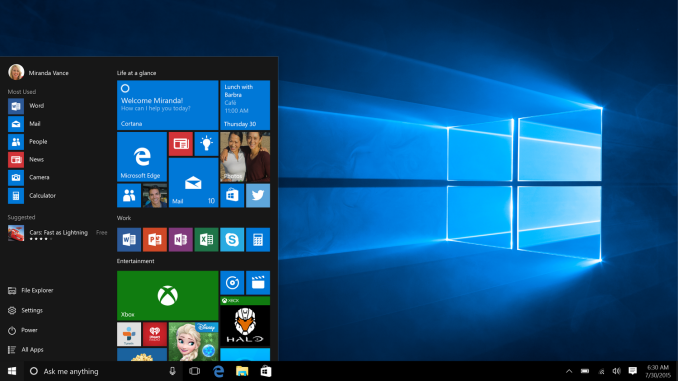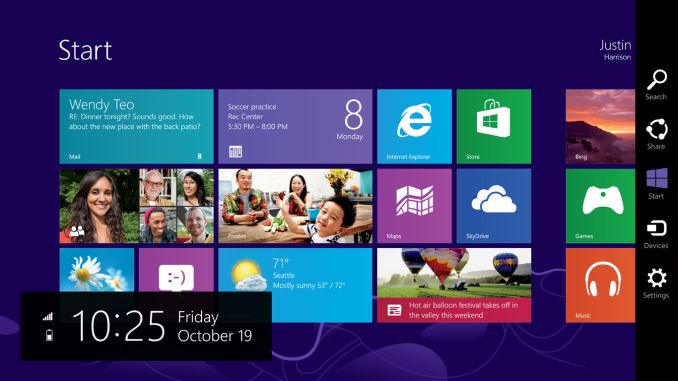The Windows 10 Review: The Old & New Face of Windows
by Brett Howse on August 25, 2015 8:00 AM EST- Posted in
- Operating Systems
- Microsoft
- Windows 10

Let’s flash back to 2012. About three years ago, Windows 8, the last major release of Microsoft’s ubiquitous operating system, was released to manufacturers. This was to be Microsoft’s most ambitious release yet. Traditional PC sales were in decline, and more personal devices such as the iPad tablet were poised to end the dominant PC platform. Microsoft’s response to this was to change Windows more than in any previous release, in a bid to make it usable with the tablet form factor. Windows 8 launched in October 2012 to much fanfare.
There was much fanfare, but little in the way of sales. Yes, Microsoft did sell many copies of Windows 8, but it did not help the declining PC market rebound. Windows 8 came to be with a touch first interface, with a new Start Screen replacing the traditional Start Menu, and a new breed of Windows 8 apps, which run on the WinRT framework. These WinRT apps have been named many things over the past three years, starting with Metro apps. A trademark dispute ended that naming scheme though, and over time they have morphed from full screen apps to universal apps to Windows Store apps, and practically none of them were able to rival the older Win32 platform in popularity or productivity.
Windows 8 did bring some great features to Windows, but they were overshadowed by the major design shift which, while good as a touch based operating system, alienated many who still used Windows on a traditional desktop or notebook. The Start Screen was a big turn off to many people, and full screen apps were not very efficient on a large screen display. Even the multitasking in Windows 8 was less than ideal, with the initial release only allowing two Windows Store apps to be open at any one time, and the second was relegated to a small side bar.
Microsoft’s own faith in Windows 8 was clearly not strong. Only a couple of weeks after Windows 8 launched, they unceremoniously dumped the project head Steven Sinofsky from the company, and spent the next two years trying to make Windows 8 more usable on traditional mouse and keyboard type machines, which were the vast majority of Windows devices in the hands of users. Windows 8.1 arrived and fixed some of the key issues with Windows 8, and 8.1 Update launched with the ability to boot to the desktop, and avoid the touch interface almost completely if you wanted to.
 Windows 10 Start Menu and Desktop view
Windows 10 Start Menu and Desktop view
When looking at Windows 10, I think it is pretty important to look back over the last three years, because none of this is ever built or designed in a vacuum. Microsoft has a huge number of devices running Windows, but a large majority of them are running Windows 7, which was an evolutionary desktop upgrade. Windows 8 struggled to ever take over any of that usage share. Windows 10 is Microsoft’s attempt to bridge the divide. Windows 7 is used by hundreds of millions of people, but its touch support is practically zero. Windows 8 works well in a touch scenario, but is not ideal for keyboard and mouse based devices. Windows 10 promises to be the version of Windows which bridges this gap.
Windows 10 brings about as much change as Windows 8 did, but in almost all cases it is going to be appreciated by users rather than avoided. It will run on a dizzying number of device types, including the traditional desktop, notebook, tablet, two-in-one, phone, IoT, Raspberry Pi, Hololens, Surface Hub, and even Xbox One. What it will bring to each of those device types is not the single interface that Windows 8 pushed on the desktop, but a unified app platform. Each device type will have its own interface, but the underlying app platform will allow developers to target a huge number of devices. And developer buy-in is the one thing Microsoft needs more than any other in order to make this vision succeed. For all of Windows 8’s quirks, it was really the lack of quality apps in the Windows Store which was the one hurdle Microsoft could not code around. Only time will tell whether or not the new model succeeds where the old one failed, but at the beginning of the life of Windows 10 we can go through all aspects of it and see what’s new, what’s changed, and how it fits in on today’s devices.











293 Comments
View All Comments
bigboxes - Wednesday, August 26, 2015 - link
Please stop. You've made your opinion perfectly clear. However, you don't need to spam up the comments section. You're don't have the only opinion. I may even agree with you on the ultimate fail of Win10, but you're not helping your cause any by repeatedly saying the same thing.tonytroubleshooter - Tuesday, August 25, 2015 - link
Gotta love WIndows.. i dont understand, if a GUI lets you click an icon so you dont have to open it, and a shortcut icon can take you to that icon, then WTF else do you really need in a GUI? not more shortcuts to shortcuts... but I guess i am wrong... so wrong.. .lol oh yeah libraries.. oh my god dont get me started on those, : takes a shot of vodka ; for shame Microsoft for shame....tonytroubleshooter - Tuesday, August 25, 2015 - link
CORRECTION:if a GUI lets you click an icon so you dont have to type it out**
Norzman - Tuesday, August 25, 2015 - link
You need to correct the line about there not being folders in the Windows 10 start menu under "All Apps". Both of my windows 10 machines have folders in the start menu apps list. It looks like this http://imgur.com/tBwwg6RBrett Howse - Tuesday, August 25, 2015 - link
Thanks for that I've re-worded the text.uhuznaa - Tuesday, August 25, 2015 - link
To be honest, I (finally!) like the direction MS is going here, with the possible exception that there is still too much cruft they didn't toss out. OK, MS is cursed with having to provide 20 years or so of backward compatibility, but Windows had grown into an unmanageable mess.There's still lots of work to do, but this is the first time in a very long while that I think MS is going somewhere instead of stagnating and sooner or later being left behind. MS can count itself lucky that Google did never even try to make Android more suitable for desktops or things would have looked much, much worse for MS meanwhile than they do. Sometimes I really think Google knows very well that with a bit of work Android could be on the way to World Domination and they deliberately let this slip (apart from smartphones) just to not find themselves in a nasty monopoly situation a bit further down the road. I mean, if they had just added a cleaner model for third-party drivers, better mouse/keyboard support and multitasking/split-screen support and I guess half of the usual desktop computers could just as well be replaced with Android on ARM machines now. And in fact despite all the security/privacy shortcomings in Android it's still far ahead compared to Windows.
All the PC-nerds here stuck in the good old times will never understand this, but from the POV of modern mobile OS'es the usual PC environment is a nightmare. Little to no sandboxing, little to no rights management for apps ("programs" for you) and hardware... The fact that every bit of code on a PC still can access the microphone and camera and happily read all files in reach really feels like a thing of the distant past in 2015.
Ananke - Tuesday, August 25, 2015 - link
If Google make Android a full desktop OS, they will end up paying so much royalties to MS, that MS will actually make more money that way, instead of selling its own products. Even now, MS is the biggest monetary beneficent of Android anyway. Btw, another reason to not have good accessories support in Android - MS holds so many patents in that area. Why do you think MS is in the business of keyboards, mice, cameras, game controllers etc etc input devices ? It holds patents and collects royalties. Hefty royalties.chrome_slinky - Wednesday, August 26, 2015 - link
It is that way only because no one has the balls to go to court. No one has PROVEN that they own any of what is in Android.uhuznaa - Wednesday, August 26, 2015 - link
Technically Android already DOES support USB- and BT-keyboards and mice. What lacks is the basic comfort of shortcuts, context menus and (international) keyboard layouts. I doubt that this would conflict with any (more) MS patents, especially since even every Linux desktop offers lots of convenience here... And isn't there split screen support in Android M now anyway?Also, I'm not talking about "a full desktop" OS. I'm talking about supporting convenient, basic support for using the bloody thing on laptops and desktops. It would be more of a "full desktop OS" than ChromeOS (which doesn't seem to cause too much patent trouble for Google by the way), but less than Windows. Android lacks just very little here, but what it lacks still makes it a bad choice for anything you use mainly with a keyboard and a mouse.
brucek2 - Tuesday, August 25, 2015 - link
Has Microsoft made any (binding, enforceable) promises about functionality that is currently free / included going premium subscription in the future?Because of the aggressive promotion, initial no charge, and very one sided rules about no consumer control of updates, I am concerned that the ultimate plan is for Win 10 to start charging monthly fees for ever-increasing subsets of functionality. The early example is solitaire, formerly free in previous Windows versions but now requiring a monthly fee. I don't care about that game in particular but MS has plenty of levers it could move that I do care about: i.e., "premium" charges for running more than X apps at a time, or using more than Y GB of RAM, or using disk speeds above 100 MB/sec, etc etc etc.
What if anything is to stop them from a "boil the frog" approach where the update that is initially free is soon $25/month or more for the same level of functionality within a couple years?